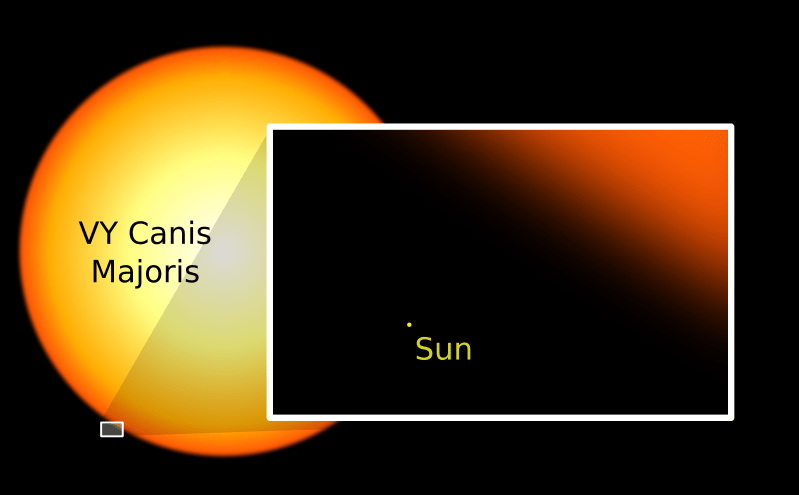Three-dimensional models of astronomical objects can be ridiculously complex. They can range from black holes that light doesn’t even escape to the literal size of the universe and everything in between. But not every object has received the attention needed to develop a complete model of it, but we can officially add another highly complex model to our lists. Astronomers at the University of Arizona have developed a model of VY Canis Majoris, a red hypergiant that is quite possibly the largest star in the Milky Way. And they’re going to use that model to predict how it will die.
How red hypergiants die has been a matter of some debate recently. Initially, astronomers thought they simply exploded into a supernova, as so many other stars do. However, more recent data show a significant lack of supernovae compared to the numbers that would be expected if red hypergiants themselves we to explode that way.
The going theory now is that they are more likely to collapse into a black hole, which is much harder to observe directly than the initially suggested supernovae. It remains unclear what precisely the characteristics of the stars that would evolve into black holes are, and to find out; it would be beneficial to have a model.
Enter the team from UA. They picked VY Canis Majoris as an excellent stand-in for the type of red hypergiants they were interested in learning more about. The star itself is massive, ranging from 10,000 AU to 15,000 AU in size, meaning it would reach 10,000 to 15,000 times farther out than the Earth is from the Sun today. And it is only 3,009 light-years away from Earth as it is. This makes VY Canis Majoris, which resides in the southern constellation Canis Major, fascinating to observers.
Its sheer size and proximity to our solar system make it an excellent observational candidate. With good observational data, astronomers can see the breathtaking complexity of what the star’s surface actually looks like.
One of the fundamental processes in a star’s death is mass loss. Typically, this happens when gas and dust are blown evenly out of the star’s photosphere. However, on VY Canis Majoris, there are massive features that are similar to Earth’s coronal arcs but a billion times more massive.

Credit – Wikipedia user Svartkell
The UA researchers used time on ALMA to collect radio signals of the material that is blasted into space as part of these eruptions. That material, including sulfur dioxide, silicon dioxide, and sodium chloride, would allow them to detect the speed at which it moves, rather than just the static presence of other ejecta, such as dust. To do so, they had to align all 48 dishes of ALMA and collect over a terabyte of data to get the correct information.
Processing all that collected data can be pretty challenging, and they are still working on some of it. Still, they had enough so far to present their findings to the American Astronomical Society in mid-June. When they have even more data, they’ll be able to describe an even better model of what one of the largest stars in the galaxy looks like. And someday, far in the future, that model of what will happen to a red hypergiant might just get a chance to be tested when VY Canis Majoris finally, officially, dies.
Learn More:
UA – Watching the death of a rare giant star
Singh et al – Molecules and Outflows in NML Cygni: New Insights from a 1 mm Spectral Line Survey
UT – VY Canis Majoris is “Like Betelgeuse on Steroids”
UT – Hubble Sees a Hypergiant Star Nearing Death
Lead Image:
Artist’s depiction of VY Canis Majoris
Credit – NASA / ESA / Hubble / R. Humphreys, University of Minnesota / J. Olmsted, STScI.


I think the size estimate for VY Canis Majoris should be 10 AU to 15 AU. rather than 10,000 to 15,000 AU as described in the UA article. This star is described elsewhere as being as large as the orbit of Saturn, which is about 10 AU.
Thank you,
Michael Purcell
Coronal arcs are on the Sun, aren’t they?